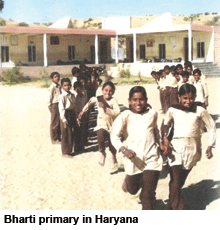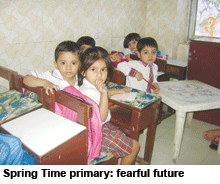Delhi: Model secondaries wariness
 Under the blueprint being finalised in the HRD ministry, private partners will procure land sites and design, develop, operate and manage the PPP model secondaries. The government will offer a 25 percent infrastructure grant and pay the tuition and other expenses of students sponsored by it. In compliance with the Right to Free and Compulsory Education Act, 2009 (aka RTE Act), 25 percent of seats will be reserved for children drawn from poor households in the neighbourhood with the government paying for their schooling. The initial contract period between the Union government and private education providers will be ten years, renewable by mutual consent.
Under the blueprint being finalised in the HRD ministry, private partners will procure land sites and design, develop, operate and manage the PPP model secondaries. The government will offer a 25 percent infrastructure grant and pay the tuition and other expenses of students sponsored by it. In compliance with the Right to Free and Compulsory Education Act, 2009 (aka RTE Act), 25 percent of seats will be reserved for children drawn from poor households in the neighbourhood with the government paying for their schooling. The initial contract period between the Union government and private education providers will be ten years, renewable by mutual consent. However Rakesh Mittal, vice chairman and managing director of Bharti Enterprises (including Bharti Airtel, India’s largest mobile telecom corporate) and trustee of the Bharti Foundation, which manages five senior secondary schools in partnership with the government of Punjab under its Adarsh PPP schools initiative, believes the PPP model can be made to work. “The Central and state governments should promote the PPP model in education in flexible ways. Apart from funding schools, private educationists and NGOs can aid teacher training, curriculum development, adopt government schools or build schools on land leased from government. Admittedly government must retain some control, but day-to-day management should be firmly invested in the private partners based on mutually agreed deliverables for the PPP model to work successfully,” says Mittal, who has considerable domain knowledge of school education. The Bharti Foundation has promoted 245 primary schools countrywide (Punjab, Haryana, West Bengal, Uttar Pradesh, Rajasthan and Tamil Nadu).
However Rakesh Mittal, vice chairman and managing director of Bharti Enterprises (including Bharti Airtel, India’s largest mobile telecom corporate) and trustee of the Bharti Foundation, which manages five senior secondary schools in partnership with the government of Punjab under its Adarsh PPP schools initiative, believes the PPP model can be made to work. “The Central and state governments should promote the PPP model in education in flexible ways. Apart from funding schools, private educationists and NGOs can aid teacher training, curriculum development, adopt government schools or build schools on land leased from government. Admittedly government must retain some control, but day-to-day management should be firmly invested in the private partners based on mutually agreed deliverables for the PPP model to work successfully,” says Mittal, who has considerable domain knowledge of school education. The Bharti Foundation has promoted 245 primary schools countrywide (Punjab, Haryana, West Bengal, Uttar Pradesh, Rajasthan and Tamil Nadu). For several years, CCS has been in the vanguard of a snowballing movement to save the country’s estimated 400,000 private budget schools in slums and shanties, eulogised by Prof. James Tooley of Newcastle-upon-Tyne University in his bestseller A Beautiful Tree (2009), for providing far superior education compared to government primaries. “Budget schools started mushrooming to fill the void created by poor quality government schools where teacher turnout is abysmally low. It’s not an easy decision for poor parents — most of whom are construction labour and factory workers — to send their children to fees-charging budget rather than free-of-charge government primaries, which not only provide free education but also free mid-day meals to their students,” says Dr. Parth Shah, former professor of economics at Michigan University and promoter-president of CCS (estb. 1997).
For several years, CCS has been in the vanguard of a snowballing movement to save the country’s estimated 400,000 private budget schools in slums and shanties, eulogised by Prof. James Tooley of Newcastle-upon-Tyne University in his bestseller A Beautiful Tree (2009), for providing far superior education compared to government primaries. “Budget schools started mushrooming to fill the void created by poor quality government schools where teacher turnout is abysmally low. It’s not an easy decision for poor parents — most of whom are construction labour and factory workers — to send their children to fees-charging budget rather than free-of-charge government primaries, which not only provide free education but also free mid-day meals to their students,” says Dr. Parth Shah, former professor of economics at Michigan University and promoter-president of CCS (estb. 1997). S. Kapoor, promoter and principal Spring Time School (estb. 2011) in Daryaganj, old Delhi, which offers English-medium primary education to 40 children aged three-ten in a tiny 350-sq. ft primary school levying monthly tuition fees ranging from Rs.500-650, is fearful of the future. “Meeting the norms specified in the RTE Act schedule is out of question. Delhi needs as many schools as it can get. I don’t see the logic of shutting down low-priced primaries which people prefer to government schools. Let them improve their standards to attract our students. That’s a better way of closing us down,” he says.
S. Kapoor, promoter and principal Spring Time School (estb. 2011) in Daryaganj, old Delhi, which offers English-medium primary education to 40 children aged three-ten in a tiny 350-sq. ft primary school levying monthly tuition fees ranging from Rs.500-650, is fearful of the future. “Meeting the norms specified in the RTE Act schedule is out of question. Delhi needs as many schools as it can get. I don’t see the logic of shutting down low-priced primaries which people prefer to government schools. Let them improve their standards to attract our students. That’s a better way of closing us down,” he says.














Add comment